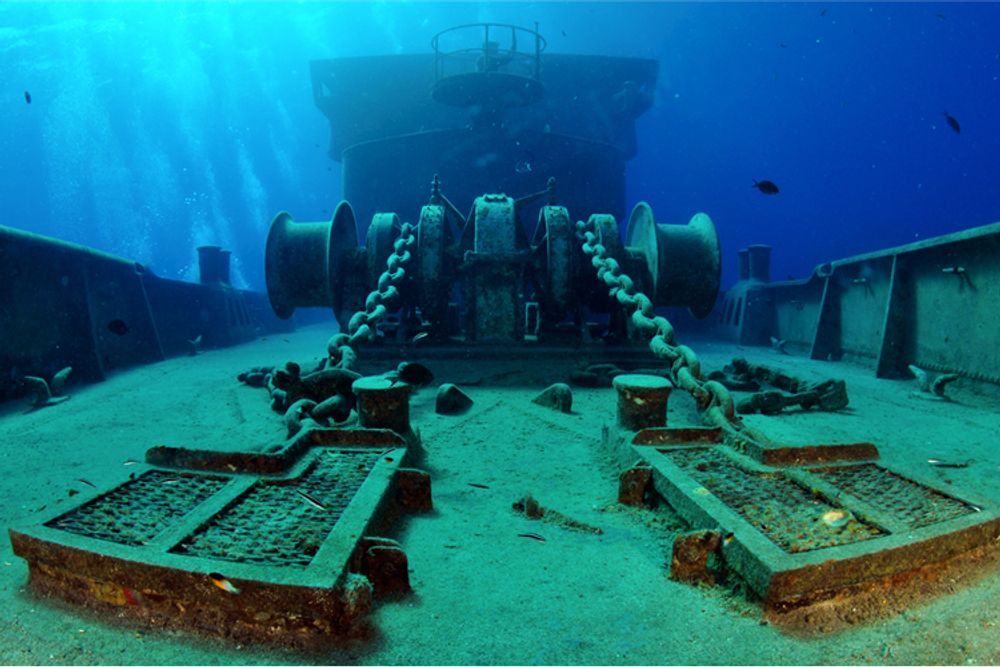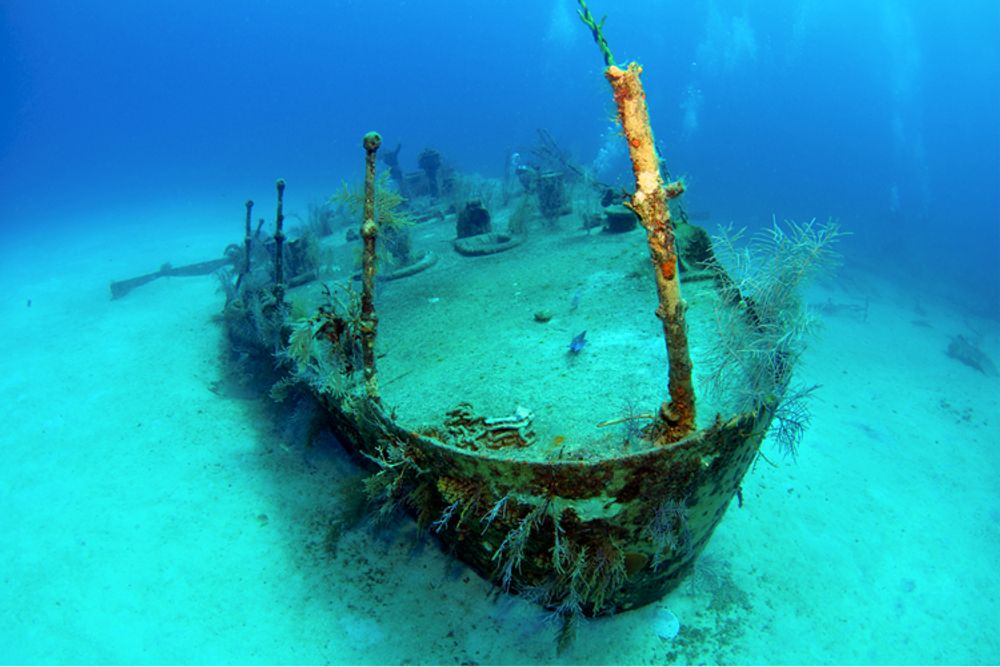
For decades, old and decommissioned vessels have been scuttled and purposely sunk to create artificial reefs. Here’s 12 beautiful wrecks around the world that have turned into new habitats for marine life and become popular dive sites
HTMS SATTAKUT, KOH TAO, THAILAND
Depth: 23 metres
The HTMS Sattakut is a huge ex-navy vessel which is 49 metres long and 7 metres wide. Originally, the Sattakut was steered by the US Navy under the name USS LCI (landing craft infantry). She played an important part in the Battle of Iwo Jima and was involved as a support ship during the atomic bomb tests at the Bikini Atoll. The vessel was commissioned to the Royal Thai Navy in 1947 and sunk by the Thai Department of Marine Coastal Resources in 2011. Now she lies about 30 metres south of the popular dive site Hin Pin Wee and has become the home to large schools of fusilier, schooling juvenile yellowtail barracuda, groupers, trevally, rabbitfish and moray eels. Marine biologists were surprised at how quickly marine life settled on the reef and expect the Sattakut’s biodiversity to improve with over time.
Dive the Sattakut with Master Divers
KITTIWAKE, CAYMAN ISLANDS
Depth: 18 metres

Now home to different species of rays, schools of horse-eye jacks and sharp-nosed puffers, the Kiitiwake has become a vibrant ecosytem since it was sunk in 2011. Before it was decommissioned in 1994, the Kittiwake spent over fifty years as a search and rescue vessel and is well recognised for recovering the black box from the Space Shuttle Disaster in 1986. At a length of more than 70 metres, the Kittiwake is quite a large wreck and used to carry more than 80 sailors at a time. In 2008, the Kittiwake was decommissioned to the Cayman Islands for the intention of creating an artificial reef. It was sunk in 2011 and lies at 18 metres below the surface – a perfect wreck for Open Water divers!
Dive the Kittiwake with Dive 356 Cayman
THE SCYLLA, CORNWALL
Depth: 24 metres
The frigate HMS Scylla was sunk in 2004 in Whitsand Bay, Plymouth to a depth of 24 metres. While its toxins and hazardous materials have been removed, divers still enjoy the radar control consoles which have been left with buttons intact. As the wreck is young, marine biologists were surprised to see how quickly marine life moved into the reef. These days, the outer walls are covered in anemones and sea squirts and fish from the neighbouring wreck, the James Egan Layne, have migrated in and around the Scylla. Divers can expect to see colourful wrasse, pollack and bib fish. Before becoming a reef, the Scylla had a long and varied history serving for the Royal Navy. First commissioned in 1968, the Scylla was involved in the Cod War fishing dispute in Iceland during the 70s, performed humanitarian relief after a hurricane in the Cayman Islands in the 80s and was deployed in the South Atlantic in the 90s.
Dive the Scylla with Plymouth Diving Centre
USS SPEIGEL GROVE, FLORIDA KEYS
Depth: 40 metres

When it was sunk in 2002, the 155- metre-long Spiegel Grove was the largest artificial reef in the world. She is roughly the length of two football fields. Interestingly, the Spiegel was accidentally sunk resting upside down on the seabed. A further $250,000 dollars were spent trying to bring her upright, only to leave her resting on the starboard side. In 2005, Hurricane Dennis rolled the Spiegel onto her keel, right-side-up, in the exact position she had been intended to lie. With many openings in her sides, the wreck is a favourite for experienced divers. Almost immediately after sinking, the reef attracted Goliath grouper, large jacks and gobies.
Dive the Spiegel Grove with Blue Water Diver
IMPERIAL EAGLE, GOZO, MALTA
Depth: 32-40 metres

This 43-metre-long wreck is home to a number of octopuses, tuna, damsel fish, grouper, amber jacks and moray eel. The floor of the wreck is covered in rich red algae. Before being sunk in 1999 near Qawra Point, the Imperial Eagle was a passenger ferry which carried up to 70 passengers and around ten cars from Malta and Gozo. In the 70s she was used to transport cargo and livestock from Gozo to Valletta and later was used as a storage vessel. The wreck is widely recognised for its larger than life statue of Christ, now enveloped in corals and algae. The statue was originally blessed by Pope John Paul II and sunk near St Paul’s island in 1990 before being relocated to the Imperial Eagle in 2000.
Dive the Imperial Eagle with Atlantis Gozo
THE RAINBOW WARRIOR, NEW ZEALAND
Depth: 26 metres
The Rainbow Warrior was the flagship of the Greenpeace fleet before it was targeted and sunk by French secet service agents while it was moored at Marsden Wharf in Aukland. All crew managed to escape apart from photographer Fernando Pereira, who tragically drowned. In 1985, the wreck was re-floated but severe damage to the hull lead Greenpeace to decide to scuttle it and in 1987 the wreck was sunk in a bay off the Cavalli Islands. When it was sunk, barnacles made way to a suitably rainbow-coloured array of anemones, sponges and plants. It attracts numerous schools of roughies and bigeyes.
YO 257, OAHU, HAWAII
Depth: 26 metres
One of Oahu’s best wreck dives, the YO 257 was once a Navy refuelling vessel that was used in World War II during operations in Korea and Vietnam. Built in the 1940s, the vessel could hold as much as 200,000 gallons of fuel for feeding battleship groups out at sea. It was actually sunk in 1989 by the Atlantis Submarine Tour as an attraction but is regularly frequented by divers. As a 26-year-old reef, the YO 257 is a developed ecosystem which plays host to mantas, tiger sharks, Galapagos sharks, white tip reef sharks, dolphins, barracuda and sea turtles.
Dive the YO 257 with Oahu Diving
ORO VERDE, CAYMAN ISLANDS
Depth: 12-15 metres

Angel fish, yellowtail snappers and groupers are the regular residents to this large shipwreck off the west coast of Grand Cayman. However, there are also some rather famous residents – a 300 pound jewelfish named Sweet Lips, a six-foot-long moray eel named Kermit and a four-foot-long barracuda. The Oro Verde was sunk in 1980 and was once used a freighter by the US Navy under the name Navajo. After it was retired by the Navy the Oro Verde was registered in Nassau and ran freight to and from the Latin America, the Caribbean and North America. Her history became shadier after 1976 when she became a drug smuggling ship before running aground on a reef near Grand Cayman. The Oro Verde was grounded there for several years until local dive operators and the government decided to scuttle it.
Dive the Oro Verde with 365 Dive Cayman
JUAN ESCUTIA, MEXICO
Depth: 28-30 metres
Located in the Puerto Morelos Marine Park, the Juan Escutia has attracted a whole host of native marine species such as eagle rays, big snappers and barracudas. The Juan Escutia is an exciting dive for the experienced diver as the engine and state rooms remain are intact and possible to visit. The Juan Escutia was once named the USS Knave and served as a minesweeper in World War II. After a fairly short service, she was decommissioned and placed in reserve. In 1996, the USS Knave was sold to the Mexican Marine and renamed the Cadete Juan Escutia before being sunk off Puerto Morelos the same year.
Dive the Juan Escutia with Planet Scuba Mexico
WRECK ALLEY, SAN DIEGO, USA
Depth: Ruby E 25 metres, Yukon 20-31 metres
Wreck Alley is a huge artificial reef system off the coast of San Diego made up of a network of six vessels. They are well positioned in the cold and nutrient rich currents, making a vibrant home for anemones, crabs, lobster, starfish and nudibranchs. By night, Wreck Alley becomes a different environment when large sheepshead and calico bass are known to sleep in the wreckage as well as some perch and white sea bass. Of the six main wrecks, the Yukon, a Canadian destroyer, and the Ruby E Coast guard cutter are the most popular. A more unusual spot nearby is the Ingraham Street Bridge, an underwater freeway made up of the rubble of the old Ingraham Street bridge which was dumped when it was replaced with the new bridge in 1992.
Dive Wreck Alley with Waterhorse Charters
HMCS CHAUDIERE, BRITISH COLUMBIA
Depth: 15-20 metres
This wreck is a 111 metre Destroyer Escort which was sunk by the Artificial Reef Society of British Columbia in the Sechelt inlet. In fact, the Chaudiere was the first destroyer to be sunk to form an artificial reef. There is usually fantastic visibility in the wintertime when divers can expect to see plumose anemone, tunicates, octopus, rockfish and schools of perch. The wreck lies on its side, however, access points have been cut into the sides so divers can explore the inner structure. It has quickly recognised as one of the best wreck dives on the Pacific Coast. Before being sunk in 1992, the Chaudiere was commissioned to the Canadian Royal Navy and later the Canadian forces from 1959-1973 during the Cold War.
Dive the Chaudiere with Porpoise Bay Charters
MV DANIA, MOMBASA, KENYA
Depth: 10-32 metres

The Dania is a 400 ton fishing trawler and significantly was the first deliberately sunk wreck in East Africa. Since being sunk in 2002, the MV Dania has become well colonised with batfish, barracuda, moray eels, glassfish, exotic grouper and a huge malabar grouper that territorially follows divers around parts of the wreck. The upper deck is accessible at a depth of just 12 metres while the keel lies at 30 metres from the surface. Curiously, the El Nino effect brought havoc on the corals near the site in 1998, with many reefs bleached and dying. After the Dania was sunk, corals have begun to thrive again. What was once a cargo ship has become an ecological success story.
Dive the Dania with Buccaneer Diving


